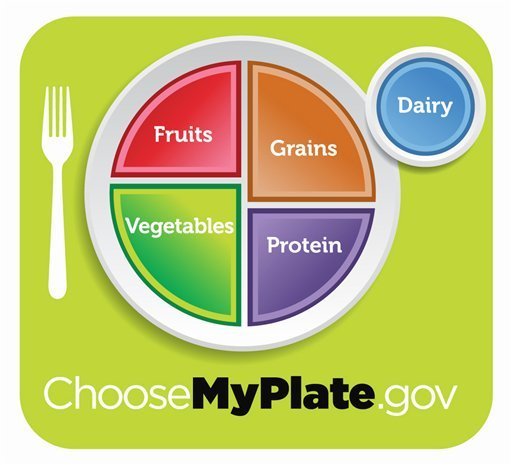 WASHINGTON (AP) -- There's a new U.S. symbol for healthful eating: The Agriculture Department unveiled "My Plate" on Thursday, abandoning the food pyramid that had guided many Americans but merely confused others.
WASHINGTON (AP) -- There's a new U.S. symbol for healthful eating: The Agriculture Department unveiled "My Plate" on Thursday, abandoning the food pyramid that had guided many Americans but merely confused others.
The new guide is divided into four slightly different-sized quadrants, with fruits and vegetables taking up half the space and grains and protein making up the other half. The vegetables and grains portions are the largest of the four.
Gone are the old pyramid's references to sugars, fats or oils. What was once a category called "meat and beans" is now simply "proteins," making way for seafood and vegetarian options like tofu. Next to the plate is a blue circle for dairy, which could be a glass of milk or a food such as cheese or yogurt.
Some critics, including congressional Republicans, have charged the Obama administration of reaching too far in trying to make Americans eat healthier, especially when it comes to new rules that tell schools what children can eat on campus.
The new plate is simply guidance for those looking to improve their diet, however. It's supposed to be a suggestion, not a direction, said Agriculture Secretary Tom Vilsack.
"We are not telling people what to eat, we are giving them a guide," he said. "We're not suggesting they should not have a cookie or dessert, that's not what it's about."
Vilsack said the new round chart shows that nutrition doesn't have to be complicated. After almost 20 years of leaders preaching good eating through a food pyramid the department now says was overly complex, obesity rates have skyrocketed. He showed off the new plate with first lady Michelle Obama, who has made healthful diets for children a priority through her "Let's Move" campaign.
"Parents don't have the time to measure out exactly three ounces of protein," Mrs. Obama said as she introduced the new graphic. "We do have time to look at our kids' plates."
The department is planning to use social media - posting advice every day on Twitter, for example. The address of the accompanying website, choosemyplate.gov, is written on the chart. That website will eventually feature interactive tools that help people manage their weight and track their exercise.
The new chart is designed to be "more artistic and attractive" and to serve as a visual cue for diners, said Robert Post of the Agriculture Department's Center for Nutrition Policy and Promotion. He has spent two years developing the plate and the website.
Even though the plate is divided into four different-sized sections, the servings don't have to be proportional, Post says. Every person has different nutritional needs, based on age, health and other factors.
The graphic is based on new department dietary guidelines released in January. Those guidelines, which are revised every five years, tell people to drastically reduce salt and continue limiting saturated fats. They say diners can enjoy food but should balance calories by eating less. The guidelines also suggest making half of your plate fruits and vegetables - a message easily translated on the dinner plate.
"We know Americans want to be healthy, but making those healthy choices is not easy, it's hard," said Surgeon General Regina Benjamin, who joined Mrs. Obama and Vilsack to unveil the plate. "We're trying to make it easier."
The guidelines and the icon were subject of lobbying by food industries who want to see their products promoted and not discouraged. Fruit and vegetable growers were celebrating their victory over half of the plate Thursday, while dairy producers said they were also pleased with the cup beside it. The president of the beef industry group National Cattleman's Beef Associaton, Bill Donald, said he is not concerned about the elimination of the word "meat" because beef is so associated with the word "protein."
The first food pyramid was introduced in 1992, with detailed descriptions of recommended foods and their portion sizes. The tip of the pyramid represented fats, oils and sweets, cautioning diners to "use sparingly."
After research showed the pyramid wasn't working, the department worked with a public relations firm and came up with an all-new pyramid in 2005 that was characterized by vertical lines of color and a stick figure walking up a staircase to symbolize exercise. At the time, officials said they wanted something motivational and recognizable. But the Obama administration eventually ditched that model, opting for something fresher.
Many nutritionists and nutrition groups praised the newest effort, crossing their fingers that people will listen.
Marion Nestle, professor of nutrition, food studies, and public health at New York University, said there are already a lot of symbols out there telling people what to eat. She said the new model isn't perfect, it's a good step forward.
"This brings it all together," she said.
Portland and Seattle
Free Subscription to Breaking News
Free Subscription to Breaking News


















































































































































































































































































































































